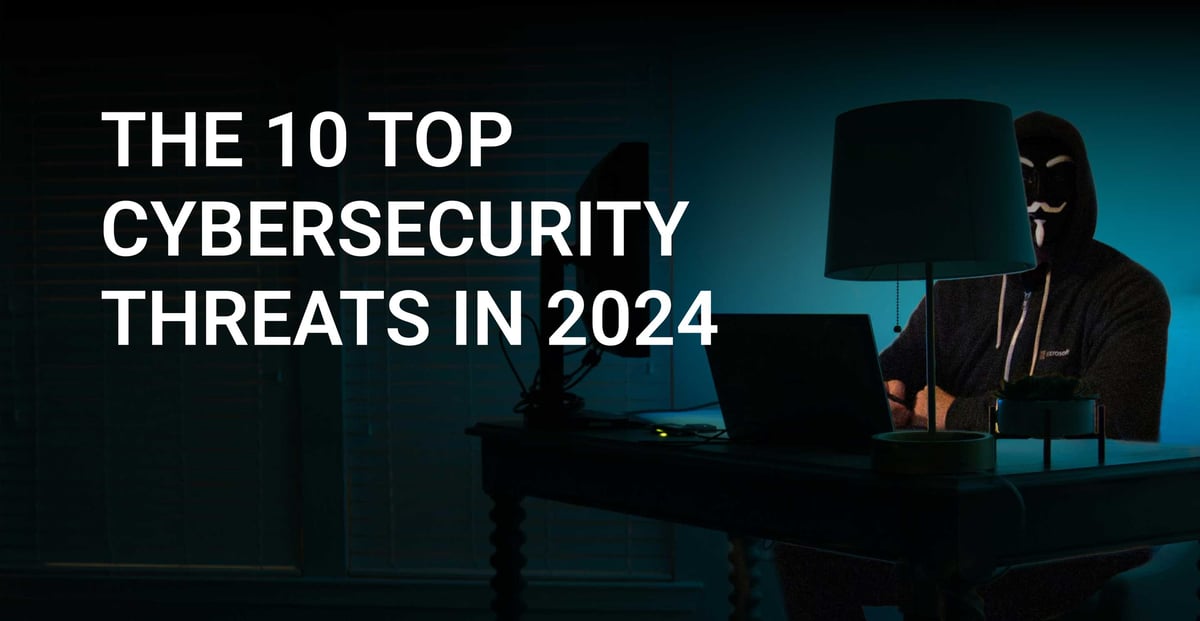In 2023, cyber threats increased and diversified, resulting in increased security challenges for organizations around the globe. Meanwhile, AI greatly increased its presence in the realm of cybersecurity, both negatively and positively.
2024 is going to be a year in which advanced AI tools and complex social engineering tactics will further alter the cybersecurity game. In this article, we will focus on the most important cybersecurity threats in 2024. What can we expect from threat actors, and how can we protect ourselves against the major cybersecurity threats that lurk in the digital shadows? Read on and find out!
Contents
- Top 10 cybersecurity threats
1. AI creates new dangers
2. Social engineering
3. Configuration mistakes
4. Poor ‘cyber hygiene’
5. Mobile device vulnerabilities
6. IoT attacks
7. Ransomware and extortion
8. Vulnerable cloud environments
9. Supply-chain compromises
10. Nation-state attacks and hacktivism
- How can we help?
Fuzztesting
1. AI creates new dangers
The rapid advancement of AI technology will enable attackers to improve their manipulation efforts. The latest generation of AI tools can be used to find weaknesses in systems and exploit them, allowing attackers to conduct attacks or large-scale phishing or disinformation campaigns. Organizations should stay on the watch for increasingly convincing fraud schemes and weak spots in their systems.
2. Social engineering
Social engineering remains one of the most dangerous hacking techniques employed by cybercriminals, mainly because this particular type of threat relies on human error rather than technical vulnerabilities. After all, human beings are easier to trick than advanced security systems. Social engineering focuses on obtaining employee data and credentials, often using phishing and email impersonation to achieve this goal. AI gives attackers extra opportunities to professionalize their scams and make phishing and impersonation efforts more convincing.
3. Configuration mistakes
Even the best and most advanced security systems often contain a couple of configuration mistakes. For example, in a series of 268 trials conducted by cybersecurity software company Rapid7, 80% of external penetration tests encountered an exploitable misconfiguration. Configuration mistakes increase the number of exploitable opportunities for cybercriminals.
4. Poor ‘cyber hygiene’
Poor ‘cyber hygiene’ can also be at the root of cybersecurity threats. Using unprotected Wi-Fi networks, failing to implement proper safeguards (VPN, MFA), weak passwords, and faulty coding are common examples of poor cyber hygiene. Companies and individuals who fail to adhere to a high level of cyber hygiene are more vulnerable than ever in our modern digital age.
5. Mobile device vulnerabilities
In recent years we have seen a serious uptick in mobile device usage. Together with the increase in remote work and increased implementation of bring-your-own-device policies, this has led to an increased risk of cyber incidents that involve mobile device vulnerabilities or malicious mobile applications.
6. IoT attacks
The number of smart devices in business environments as well as in households, has increased spectacularly in recent years. All these IoT devices are connected to the internet and receive and generate a lot of data. The combination of less-than-stellar cyber hygiene and IoT connectivity creates ample opportunities for cybercriminals to exploit device, network, and code vulnerabilities. It’s no coincidence that attacks on IoT devices have spiked in recent times.
7. Ransomware and extortion
The Google Cloud Cybersecurity Forecast 2024 predicts that ransomware and extortion operations will remain a plague in 2024’s global IT landscape. Ransomware growth stagnated in 2022 but spiked again in 2023. The profitability of these attacks means threat actors still have strong incentives to continue compromising networks and stealing sensitive data. Organizations should prioritize offline backups, incident response plans, and ensure human involvement to limit the business disruption caused by ransomware.
8. Vulnerable cloud environments
Many tech followers expect threat actors to increasingly target hybrid cloud environments and multi-clouds in 2024. Their main goal? Exploiting misconfigurations and identity flaws to jump across cloud boundaries and escalate access. Therefore, securing cloud resources, safely and rigidly managing identities, and monitoring for suspicious internal activity are key if organizations want to get a tight grip on this specific security challenge.
9. Supply-chain compromises
Supply-chain compromises affecting software and dependencies are also expected to persist. Companies and projects are increasingly interesting targets for threat actors seeking to initiate compromises via widely used open-source packages. Rigorous vetting of third-party code and monitoring of package registries can help you reduce the risk of supply-chain compromises. Be proactive and check in advance the important dependencies before official alerts (CVE) are out in the field.
10. Nation-state attacks and hacktivism
Google also predicts that nation-states will continue to conduct cyberattacks to achieve geopolitical goals. The tech behemoth also expects a rise in hacktivism and other cyber activity related to major global conflicts and elections (elections will be held in 40 countries in 2024). Therefore, companies should raise their awareness levels to recognize and effectively deal with nation-state attacks and hacktivism.
Fuzz testing
An important and increasingly popular trend in the testing and security landscape is fuzz testing. Fuzz testing is an automated software testing method that injects invalid, malformed, or unexpected inputs into a system to reveal software defects and vulnerabilities. According to Forrester, 65% of security decision-makers are adopting fuzz testing, while 16% plan to implement it.
Tech corporations like Microsoft and Google were early adopters of fuzzing technologies to test their own systems. Since launching in 2016, Google's OSS-Fuzz, a free fuzzing platform for critical open-source projects, has helped fix over 8,800 vulnerabilities and 28,000 bugs across 850 projects.
Learn more about fuzz testing and how it helps companies automate testing and harden software download a free factsheet.

